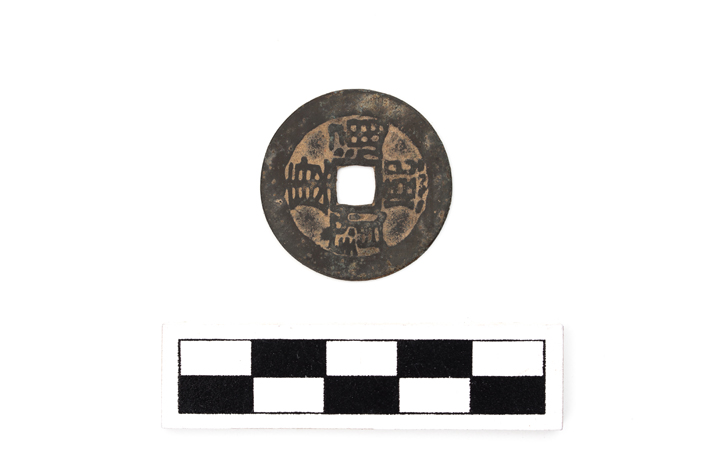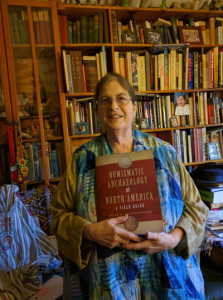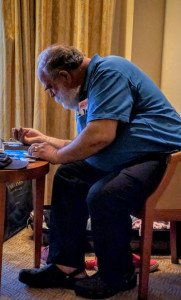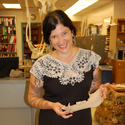Digging Jacksonville – August 2016
Excavations at Jacksonville’s Chinese Quarter resulted in a small assemblage of coins that burned with the house in the fall of 1888. Through numismatics, the study of coins, it is possible to see past the damage and determine how they were used prior to the fire. The numismatic material included coins from the United States, China, Hong Kong, and Vietnam, a common assortment for the time and place.
The intense heat caused considerable damage, and some coins were difficult to identify fully. However, it was possible to determine that the Asian coins consisted of 10 cast brass Chinese wen coins, (some in fragmentary condition) one struck bronze coin from Hong Kong dated 1866, and 37 cast-zinc Vietnamese dong coins (most in fragmentary condition). Additionally, there is one group of six to ten Asian coins that were so badly melted that only the distinctive traditional shape shows their origin.
The very large percentage of zinc coins from Vietnam indicates close ties with southern Chinese ports between 1880 and about 1895, as zinc Vietnamese dong coins circulated in Guangdong province only during this period. The date of the fire in 1888 is in the middle of this period.
In addition to the Asian coins, ten United States coins were also recovered. One 1843 dime was recovered, without much damage other than the wear of many years of circulation, and nine quarters, all of which that were too melted to be identified as to date or even type. One is an individual coin, the other eight, in the form of a small stack, are melted together along their edges.
As United States coins were the circulating medium in the economy, the presence of a few US coins at any Jacksonville site is to be expected. But it should be kept in mind that quarters were commonly used in gambling as a standard substantial wager. Gambling was essentially the only use of the Vietnamese coins in American Chinatowns, and a very common use of the smaller Chinese coins. Both melted-together groups of coins were found in an open area of the house where the fire was hotter, and where other gaming paraphernalia, such as glass game pieces, turned-up.
Chinese wen were used as markers, game pieces, and to represent stakes, (like poker chips) but they served some non-gambling uses, as well. Many Chinese coins served as talismans, (charms for protection and good fortune) particularly older and larger ones. Of the ten Chinese coins, the oldest one at the site was from the Shun Zhi reign (1644-1661) and one was from the Kang Xi reign (1662-1722). Kang Xi’s reign was remarkably long and his coins were kept as special keepsakes in the hope of bringing that longevity to the owner. The Kang Xi coin, the Hong Kong mil, and the US 1843 dime were all found in a different area of the burned house from the gaming paraphernalia.
Asian coins also had medical uses, both for rubbing the skin and for making medicinal teas containing zinc. Also, Chinese coins have been used as decorations, often on clothing, sometimes on baskets, although there is no direct evidence for such uses at this site.
Marjorie Akin works as an applied medical anthropologist, in addition to writing on a wide range of topics. Her area of specialization is numismatics. She is active in the Riverside, California “Save Our Chinatown Committee,” working to protect the archaeological remains of Riverside’s Chinatown from development.
Retired steam engineer and historian Kevin Akin has lived and worked his entire life in the Riverside, California area. Two of his books on local history have been published, along with articles on numismatics. He has assisted his wife, Margie Akin for 42 years, and is the junior author of Numismatic Archaeology of North America.



 Chelsea Rose is an historical archaeologist who specializes in the settlement and development of the American West. Chelsea and the Southern Oregon University Laboratory of Anthropology (SOULA) conduct archaeology across Oregon and have done several projects in Jacksonville. You can reach Chelsea at rosec@sou.edu and follow SOULA on
Chelsea Rose is an historical archaeologist who specializes in the settlement and development of the American West. Chelsea and the Southern Oregon University Laboratory of Anthropology (SOULA) conduct archaeology across Oregon and have done several projects in Jacksonville. You can reach Chelsea at rosec@sou.edu and follow SOULA on